
The main aim with the summer asana practices is to open up the gallbladder channel on the side of the body and also stimulate and activate the liver channel on the inside of the legs. Strengthening the upper chest and upper back areas will provide us with more strength while also stimulating digestive fire. Because, the wood element governs the tendons and ligaments, spring is the best time for twisting movements and postures as it helps to keep the ligaments ad tendons healthy. Cooling practices can also be included to help avoid excess fire in the liver.
Below are some asanas that achieve these aims. Incorporate these postures into your asana practice during spring will help to balance the liver and gallbladder.

Extended Side Angle Pose – Utthita Parsva Konasana
Main Benefit – Opens the side of body where the gallbladder meridian travels.
1. Extend the legs wide apart and bring your right toe to face down the mat and the back toes to turn out to the side at around 45 degrees.
2. Bring your hands to your hips to start with and start to bend into the front right knee. Make sure your knee is either above your ankle or just behind it, don’t let it pass over the ankle as this puts to much stress on the knee joint.
3. Bring your arms up to shoulder height, shoulders relaxed, palms facing down.
4. Now start to reach forward with your right arm, bring your torso forward also, and then place the right elbow onto the knee. Bring the left arms past your ear palm facing down. Look out to the side or up under the arm.
5. Keep your legs strong, draw the belly in, try and relax the upper body.
6. Come out by drawing the arms and torso back to centre, and releasing the legs.
7. Repeat on other side
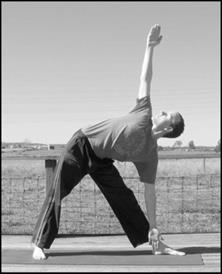
Triangle Pose - Trikonasana
Main Benefit – Opens the side of the body where the gallbladder meridian travels.
1. Bring your feet to about 1 meter apart, not as wide as the warrior 2 pose.
2. Turn the left toes to face the front of the mat and the back toes about 45 to 90 degrees.
3. Bring both arms up to shoulder height, keep your legs straight and then start to bring your arms and torso to the front of the mat as far as you can go.
4. Then simply draw your left arm down onto the left leg, above the ankle a few inches and draw the right arm up to the sky.
5. Keep the chest open. Look to the floor, out to the side or, if the neck is ok try tucking the chin into the right shoulder and look up towards top hand.
6. Keep your legs active by pulling up on the kneecaps. Keep the belly sucked in slightly, steady breathing.
7. Get a sense of pushing the right hip out to the side.
8. Hold for a few breaths and when ready, come out by softening the knees and drawing yourself up.
9. Repeat on the other side.
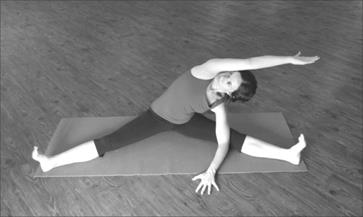
Sitting Side Bend - Parivrttta Janu Sirsasana
Main Benefit – Opens the side of the body where the gallbladder meridian travels as well as opening the liver meridian on the inside of the legs.
1. Bring the left leg straight out to about 45 degrees and the right knee bent with right foot into inner left thigh.
2. Then bring both arms up above the head, draw the belly in and then start to drift the arms and torso over to left leg slightly twisting the torso.
3. Bring the left arm down to the left eg, or floor, wherever it works for you and continue to let the top right arm drift towards the left leg.
4. You can look out to the side or if the neck is ok and you can keep your chest open, try looking up underneath the top arm.
5. Keep your belly slightly drawn in with this pose.
6. Use your exhalation breath to soften into the pose and the inhalation breath to lengthen.
7. Stay for at least a few good, deep breaths, close your eyes if you like.
8. To come out simply draw your torso back towards centre and rest the arms.
9. Repeat to the other side.
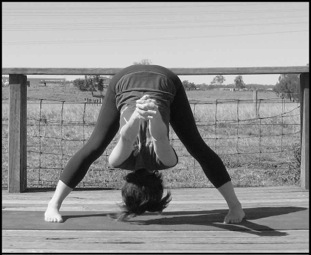
Wide Legged forward Bend (variation) – Prasarita Padottanasana
Main Benefit – A cooling pose that opens the channels on the inside of the legs, arms and shoulders.
1. Take a wide legged stance with toes both facing to the side of the room.
2. Interlace your hands behind your back while upright. Then inhale, lengthen your spine upwards and then as you exhale start to stick your buttocks out behind and draw the torso forward and down while letting the arms drift up behind you.
3. Allow a few breaths to settle into this pose – keep breathing and relax your head.
4. When you’re ready to come up, bend your knees slightly, and imagine someone is behind you pulling you up by your arms bringing you upright.
5. Relax the arms and release the legs.
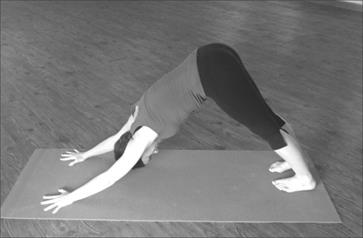
Down Facing Dog – Adho Mukha Svanasana
Main benefit – Strengthens and opens the arms, chest, shoulders and the back of the legs.
1. Come onto all fours with hands underneath the shoulders and knees under the hips. Spread your fingers wide.
2. Tuck the toes under, start to extend the arms and start bringing the knees off the floor.
3. Come to extend the arms, and start to work the kegs straight. Try to bring the weight back into your legs and not so much into your arms.
4. Look to the floor just under your belly button.

Wide Legged Forward Bend – Upavistha Konasana
Main benefit – Opens the channels on the inside of the legs and helps to re-orientate the hips.
1. Come to sit on your mat and spread the legs wide to about 90% of your capacity. If you have difficulty with this posture and find your back rounding and buttocks tucking under then place one or two folded blankets under your buttocks (slightly raising the hips in seated postures dramatically helps those with tight hips and hamstrings)
2. Now, bring your hands behind you onto the floor to help support a straight back. Sit up as straight as you can to get length in your spine and upper body.
3. Draw the toes back towards the head and gently pull the kneecaps up to activate your leg muscles.
4. When you are ready use your hands that are behind you to draw your chest forward. You can stay here if you feel a strong stretch already.
3. If you want to go further bring the hands in front of you and while keeping the lower back long, allow your chest to lower towards the floor.
4. Make sure you keep your breath flowing and stay at the sot where you feel a good stretch occurring. Stay for at least 2 minutes, making slight adjustments as you deepen into the pose.
5. When you are ready to come out, use your hands to slowly draw your torso back up to a seated position. Release your legs by drawing them together and wrapping your arms around the legs to give yourself a hug.
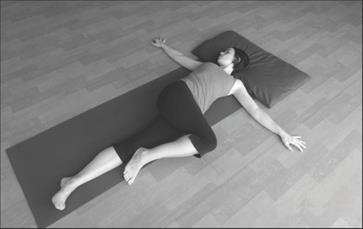
Natural Twist
Main Benefit – Squeezes the organs to support detoxification as well as stretching the ligaments and tendons.
This pose usually requires no support or props, though some people benefit from having something under the bent leg. Try it without the support first, but if it feels too strenuous or your breath is halted, then you may need to use a bolster or pillow under the bent leg. Have a bolster or pillow nearby just in case.
1. To get into this position, first just lay flat out onto the floor.
2. Bring the left arm out to the side at about shoulder height, keeping your elbow bent or your arm straight; whichever feels better and whatever you have the space for.
3. Bend your left knee so that the knee joint is sitting comfortably at about ninety degrees.
4. Bring your right hand to your left knee and start to guide the knee across your body so that you come into a twist.
5. Let the leg come as far over towards the floor as possible. It you start straining, then wither back off a bit, or bring a bolster or pillow under that bent leg so it can come to relax.
6. Find a comfortable position in which you can breathe smoothly.
7. If your neck is okay, try looking back over your left arm.
8. Stay for at least one minute.
9. Release by bringing the bent leg back up to the middle and straightening out both legs. Rest for a moment, then go to the other side.
10. Repeat steps 2 – 8 with the opposite arms and legs.

Reverse Table Top – Ardha Purvottanasana
Main Benefit – Strengthens the back of the body and opens the channels on the arms and on the front of the body.
1. Come to sit on your mat, with your knees bent and feet flat on the mat.
2. Bring your hands just behind you, fingers pointing forwards.
3. Start by raising the buttocks just off the floor.
4. If ok, raise the hips all the way so they are in line with your knees and shoulders.
5. Let your head rest back into the fold of the neck.
6. Get a sense of the shoulder working down away from the head. Allow the elbows to have a tiny bend in them, avoid hyperextending the elbow joint.
7. Plant your fingers and toes into the floor.
8. Connect with your breath and hold for around 5 long steady breaths.
9. To come out slowly lower your buttocks first, the head will naturally roll up without any effort.
10. Come to sit back on the mat.

Child’s Pose – Balasana
Main benefit – A cooling pose to calm the mind, draws energy inwards and softens the back.
1. Sit on your heels, feet flat in the seiza position (traditional Japanese posture of sitting on the heels). If it’s too much on your ankles or knees, try placing a blanket under your feet and knees. If this doesn’t work for you, then just come down into a cross-legged seated position.
2. From here, simply draw your torso down toward the floor. Rest your forehead on the floor. Relaxed arms can be out in front or down the side.
3. Close your eyes and take a few breaths, relax your back and shoulders.
4. When you’re ready to come out, simply draw your torso back up to sit on your heels or on the floor.
- The child’s pose can be done anytime you feel like you need to have a rest or break, especially in yoga class.
Other techniques that regulate the Liver and Gallbladder:
Pummeling the body
This is a common practice in the arts of qi gong and tai chi. It involves simply the act of drumming and pummeling various parts of the body with loose fists. If you have ever travelled to Korea, Japan or China you will often see older people in the park practicing this pummeling technique. The primary benefit and purpose of this practice is to free up any energy stagnation in the system. Often after a pummeling the body for 5 – 10 minutes the body will feel very “buzzy” and it also produces a very calming affect. It is often a useful and effective technique to reduce pain related symptoms because in Oriental medicine pain is primarily seen as the stagnation of Qi energy. Therefore freeing up any Qi energy stagnation will relieve pain related symptoms.
Here is some instruction on how to pummel your arms and your legs to remover energy stagnation:
Shoulders and Arms
1. Hold a loose fist with your right hand and gently, yet firmly (we want the body to shake to the pressure of the pummel but we don’t want to produce pain) and start to pummel into the muscle between the tip of your left shoulder and your neck (the trapezius muscle).
2. After a minute start to pummel down the outside of your left arm. When you reach the hand turn the hand over and gently pummel up the inside of the left arm.
3. Go up and down the arm about 2 or 3 times and then swap hands and do the same thing on to the right shoulder and arm.
Legs
1. Bring both hands into a loose fist and start to pummel the top of the buttocks. Allow your arms to be as relaxed as you can, keep the elbows soft as you pummel.
2. After a minute or two start to slowly move your pummeling down the outside of your legs. Down the thighs, avoid the knees and pummel down the outside of the calves.
3. When you reach the feet bring the hands to the inside of the ankles, a little softer now as you begin to pummel up the insides of the legs. The inside of the legs is generally more sensitive then the outside of the legs so take it easier when working with the inside of the legs.
4. Pummel slowly all the way up to the inner thighs and then move the hands back around to the top of the buttocks to do another round.
5. Complete 2-3 rounds and then stand, release your hands, close your eyes and just take a moment for your body to settle. Can you feel it buzzing?
Massage the Organs
Massaging the organs stimulates and triggers the organs into action. It also helps to squeeze toxins out of the system.
1. There is an easy way to massage the organs by lying on a yoga mat on your belly. Relax your head either to the side or bring both hands up to under your chin and place your head on your hands.
2. Bend your knees and let your feet dangle in the sky.
3. Then gently start to make circles in the air with your feet. (feet going in the same direction). You should feel a pressure in the belly area and it will move around your belly area as you move your feet. Continue for about a minute and then rest
There are plenty of other ways to massage the organs but it is advised to either attend a suitable yoga class, a workshop or get guidance from a health professional as to how to go about it.
Qi Gong & Free Flowing Movements
The movements of Qi Gong are perfect for liver energy. The liver loves movement and it especially loves smooth movements, which are found in Qi Gong. Qi Gong movements take some time to get used to and therefore it is advisable to attend some classes to get the feel of it. Once you get the feel of it, you can return to it at any point and explore it in your own way. If you are a yoga or movement teacher, incorporating some forms of Qi Gong movements during spring will add more power to your classes and it will help smooth out everybody’s liver and gallbladder energy.
Qi stagnation is one of the common causes that lead people to mild depressive symptoms. It can easily and effectively be relieved through removing stagnation through Qi Gong and most martial arts practices. Also, going out for regular walks every day will dramatically improve their overall wellbeing.